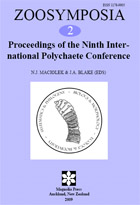Abstract
Two new species of Diplocirrus Haase, 1915 are described from the southern Irish Sea and South Africa. Diplocirrus stopbowitzi sp. nov., identified from several surveys around the Irish Sea in recent years, favors coarser sediments than D. glaucus (Malmgren, 1867), the only other species of Diplocirrus identified from the area. It is morphologically closest to D. capensis Day, 1961 from South Africa, due to a combination of characters (multiarticulated, hooked neurochaetae, cephalic cage absent) that have previously been considered unique to D. capensis within the genus. The other new species, D. incognitus, is described from material identified by Day as D. capensis and deposited in the Natural History Museum, London. In appearance, it approaches D. glaucus but differs most noticeably in the relative size of adherent sediment particles and in the length of papillae clustered around the notochaetae. The two new species exhibit characters that bridge the gap between D. capensis, previously considered anomalous, and the other members of the genus. The significance of hooked neurochaetae is discussed following the discovery of such chaetae on specimens of D. glaucus and D. hirsutus. Diplocirrus glaucus, D. capensis, and the two new species each possess the same two branchial forms: stout, cuneiform with longitudinal ciliated ridges and cirriform with transverse ciliated rings. Comparisons are also made with the morphologically similar genera Bradiella Rullier, 1965 and Diversibranchius Buzhinskaja, 1994.

